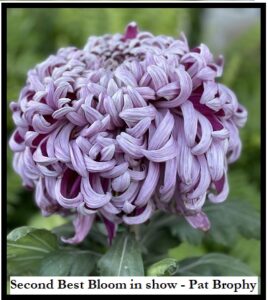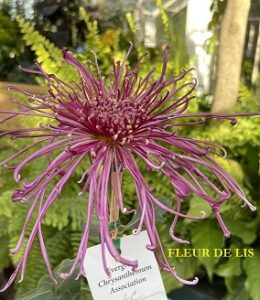Quick growing notes(preamble?):
You’ll need some or most of the supplies noted in the newsletter when you move on to the final 9″ pots.
The M&R Mix and pumice are part of the standard 9″ mix along with some Cedar Grove or other brand of compost.
Note the Cedar Grove compost is available at McClendon’s Hardware and many garden stores. It contains no Manure.
Some other brands of compost do contain significant amounts of manure.
A small quantity of moist manure is recommended to provide microbe action in the otherwise dry mixes. If you have
manure already in your chosen compost, you may choose not to add more. I Generally throw in a med. shovel of manure with every bag of Cedar Grove.
The Marathon is required to eradicate Black Aphids. Please don’t bypass this step as Black Aphids are a scourge on the Chrysanthemum and can’t be eliminated by any other method.( not even lady bugs, liquid sprays or insecticidal soaps soaps.)
TO DO LIST for June (revised DRS May 2012)
Stopping:
Most plants are stopped April 15 through June 1, including the Early English classes. Keep your stop list handy and follow it rigorously. The calendar doesn’t move backwards. For #1 and #2 varieties the English literature recommends a fairly hard pinch; that is pinching 6-8 leafs down from the growing tip. For the incurves, #3, #13, #23 pinch the smallest portion of the growing tip to get more uniform growth of the laterals. For all varieties, fertilize 1-2 weeks before pinching to produce more laterals. This is especially true for the Fairweathers.
Final Potting into 8”, 9” or 10” pots. (Or maybe in the garden soil)
Preparation
Wash clay pots in a mild Clorox solution, then rinse in clear water. Keep washed pot in the rinse water for 4-5 minutes to assure getting the Clorox out of the clay. Change rinse water occasionally. Plastic pots don’t need long rinse time, but could benefit from washing with Clorox solution.
Prepare final potting mix. Starting with our basic M&R mix, we add compost or good loamy soil, some screened coarse pumice, a small amount of well composted horse manure, and alfalfa meal.
The component mixture (by volume) is then:
M&R Soilless-6 parts, Compost or loam-4 parts, Coarse pumice-1 part
Horse manure-1/2 part, Alfalfa Meal- a hand full.
The Compost or loam is added primarily to ensure a lot of trace elements and to improve the moisture holding capability of the mix so that the pots don’t require watering twice a day for instance. The horse manure provides lots of microbes to quicken the soil break down and release of the nutrients. Many growers have gone into the final potting using the straight M&R mix with some significant success.
Potting (Pot on when the ring of roots around the bottom of the pot is semi root bound.) Cover drain holes in bottom of clay pots with a piece of broken crock to keep drain clear. Put a layer of broken sod or course pumice in the bottom of pot, then cover with 1 or 2 inches of the final (9”) mix. Place the 6” root ball on top of the 9” mix and fill around with the 9” mix. The top of the root ball should be 1+ inch below the top of the pot. Do not pack the mix except as necessary to hold the plant and stake in place. Stake with shingle or bamboo stick.
Add Marathon Systemic at this time to control black aphids. Sprinkle ½ tspn. Marathon on top of soil when repotting plant, add a thin layer of mix over the top, then water moderately.
Note: When potting on occurs after June 1, Consider dropping down one pot size pot because the roots will not have time to fill the bigger pots. # 1 & #2 cultivars, 9” max, 8” could be used. #3s, 8” max.
Feeding and pest management
· After 3 weeks in final pot start summer feeding program. ` 1 1 to 2 Tsp. Peters 20-10-20 per gallon water, once a week.
Note: Some plants will thrive with the heavier solution, while others
may not like so much fertilizer. Watch the leaves to gauge the fertilizer needed. If leaves become hard and curl up you are overfeeding. If leaves are somewhat weak and lighter green then more fertilizer would help. Miracle Grow is also used quite successfully by some during this summer stage.
· If plants are yellowish, first try drying them out. If drying the plant is unsuccessful, feed ½ tsp. Epsom Salts per plant. Leaf feeding of liquid iron such as Greenall or Sequesterine also helps green up the plant. Follow product directions. Do not over feed Liquid Iron.
· Review your pest management program every 2 weeks,
Marathon systemic is the most effective black aphid control.
Diazinon and most rose insecticides are somewhat less effective, and require spraying every 2 weeks, as they are contact insecticides. Spray every two weeks with a fungicide. Ortho Funginex is recommended. Other fungicides will work well if used regularly. If fungus gets away and is growing fast, a fungicide used to control early blight in tomatoes will really shut it down. I use Monterey “Bravo” for such control.
4. Lateral Control
As side laterals develop after the final pinch, select the number of laterals to carry through the summer and remove all other side shoots. Generally the topmost lateral below the stem break is removed, as it is the weakest lateral structurally and easily broken off by accident. At this early stage you should carry 1-2 more lateral than you want at the bloom stage. An old saying goes: “I grow 2 for me and one for the bug.”
Surplus laterals are removed later in the summer using the following guide.
For #1 & #2 cultivars, carry 2 or 3 laterals initially, cull to 1 or 2 in Aug.
For #3 cultivars, carry 5 laterals and cull Sept. or Oct.
For #4 & b#5 cultivars, carry 4 to 5 laterals and cull to 2 to 3 in Sept.
For Earlies (13-15 and 23-25) carry 4-5 laterals and cull to 2-3 in Sept.
For Spiders, Quills, Spoons, Singles etc. follow the guide for #4 and #5.
Note: Cutting back to the few laterals seems to be a most difficult task for the novice. You must do it however if you wish to get large blooms.
5. Staking.
By now all plants will require staking. A 16-24 in stake should be placed along the main plant stem and tied to it to support and protect the plant. As the side laterals develop it will be necessary to add longer stakes that can support each lateral all the way to bud development. Care must be exercised so as to not spread the new laterals too far apart when staking, as one or more could be broken off. In other words let the laterals grow till they can be easily tied to the new stakes.




